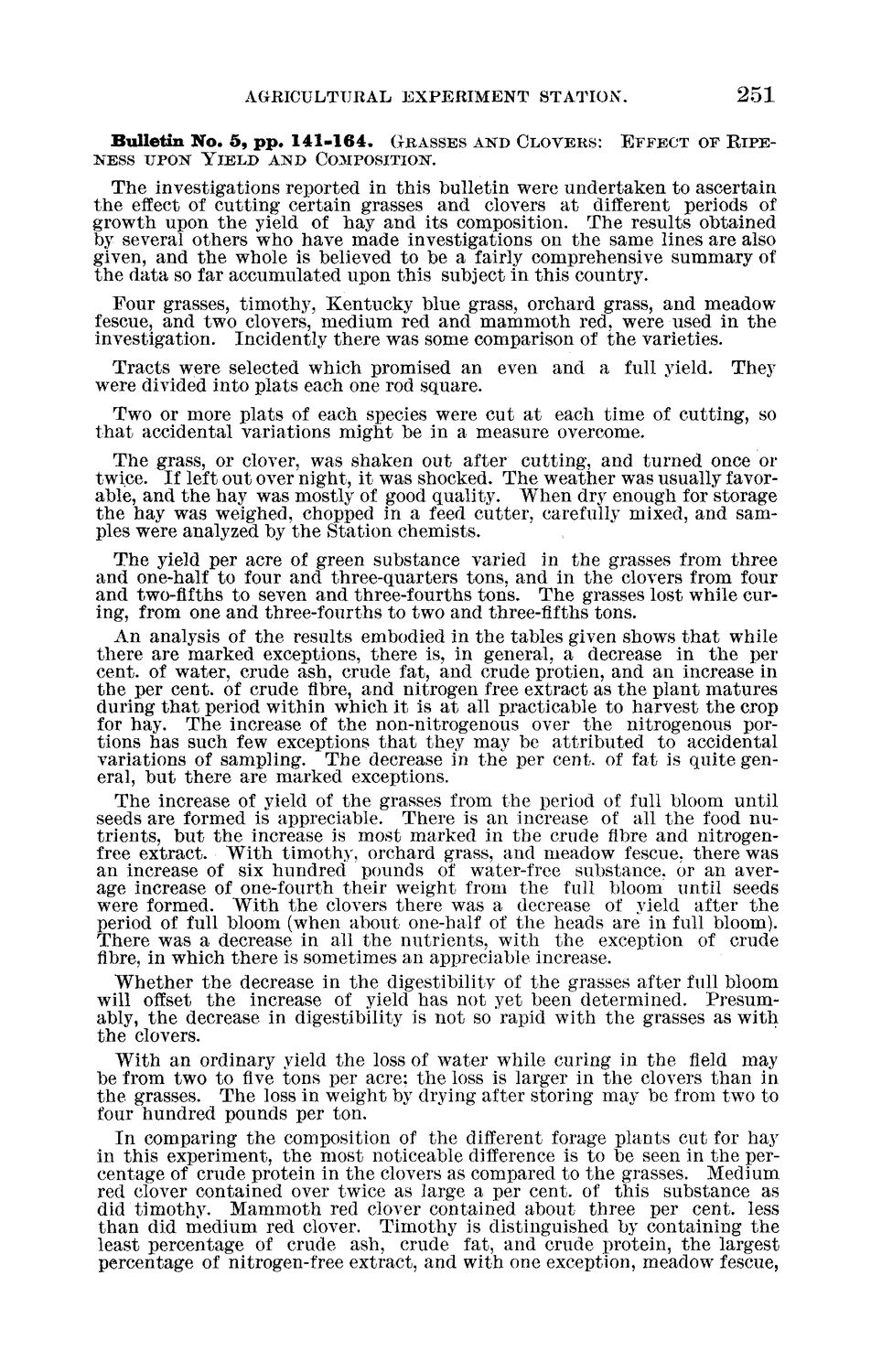| |
| |
Caption: Board of Trustees Minutes - 1890
This is a reduced-resolution page image for fast online browsing.

EXTRACTED TEXT FROM PAGE:
AGRICULTURAL EXPERIMENT STATION. Bulletin No. 5, pp. 141-164. GRASSES AND CUOYERS: NESS UPON Y I E L D AND COMPOSITION. 251 E F F E C T OF R I P E - The investigations reported in this bulletin were undertaken to ascertain the effect of cutting certain grasses and clovers a t different periods of growth upon t h e yield of hay and its composition. The results obtained by several others who have made investigations on t h e same lines are also given, and t h e whole is believed to be a fairly comprehensive summary of the data so far accumulated upon this subject in this country. Four grasses, timothy, Kentucky blue grass, orchard grass, and meadow fescue, and two clovers, medium red and mammoth red, were used in t h e investigation. Incidently there was some comparison of the varieties. Tracts were selected which promised an even and a full yield. They were divided into plats each one rod square. Two or more plats of each species were cut a t each time of cutting, so t h a t accidental variations might be in a measure overcome. The grass, or clover, was shaken out after cutting, and turned once or twice. If left out over night, i t was shocked. The weather was usually favorable, and the hay was mostly of good quality. When dry enough for storage the hay was weighed, chopped in a feed cutter, carefully mixed, and samples were analyzed by t h e Station chemists. The yield per acre of green substance varied in t h e grasses from three and one-half to four and three-quarters tons, and in t h e clovers from four and two-fifths to seven and three-fourths tons. The grasses lost while curing, from one and three-fourths to two and three-fifths tons. An analysis of t h e results embodied in t h e tables given shows t h a t while there are marked exceptions, there is, in general, a decrease in t h e per cent, of water, crude ash, crude fat, and crude protien, and an increase in the per cent, of crude fibre, and nitrogen free extract as the plant matures during t h a t period within which i t is a t all practicable to harvest t h e crop for hay. The increase of t h e non-nitrogenous over t h e nitrogenous portions has such few exceptions t h a t they may be attributed to accidental variations of sampling. T h e decrease in t h e per cent, of fat is quite general, but there are marked exceptions. The increase of yield of the grasses from t h e period of full bloom until seeds are formed is appreciable. There is an increase of all t h e food nutrients, b u t t h e increase is most marked in t h e crude fibre and nitrogenfree extract. With timothy, orchard grass, and meadow fescue, there was an increase of six hundred pounds of water-free substance, or an average increase of one-fourth their weight from t h e full bloom until seeds were formed. With t h e clovers there was a decrease of yield after t h e period of full bloom (when about one-half of t h e heads are in full bloom). There was a decrease in all t h e nutrients, with t h e exception of crude fibre, in which there is sometimes an appreciable increase. Whether t h e decrease in t h e digestibility of t h e grasses after full bloom will offset t h e increase of yield has not yet been determined. Presumably, t h e decrease in digestibility is not so rapid with t h e grasses as with the clovers. With an ordinary yield t h e loss of water while curing in t h e field may be from two to five tons per acre; the loss is larger in t h e clovers than in the grasses. The loss in weight by drying after storing may be from two to four hundred pounds per ton. I n comparing t h e composition of t h e different forage plants cut for hay in this experiment, t h e most noticeable difference is to be seen in the percentage of crude protein in the clovers as compared to the grasses. Medium red clover contained over twice as large a per cent, of this substance as did timothy. Mammoth red clover contained about three per cent, less than did medium red clover. Timothy is distinguished by containing the least percentage of crude ash, crude fat, and crude protein, t h e largest percentage of nitrogen-free extract, and with one exception, meadow fescue,
| |